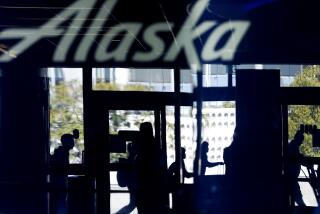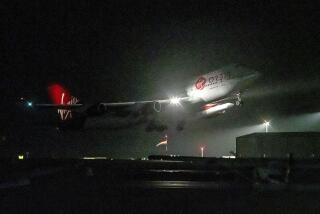Q&A; : Revising Your Travel Plans
- Share via
The sudden grounding of Pan American World Airways on Wednesday upset the travel plans of thousands of consumers, particularly those planning vacations or visits home over the Christmas holiday.
Here are some answers to the most commonly asked questions about Pan Am’s collapse:
Q: Which airlines are accepting Pan Am tickets?
A: Several U.S. airlines and one foreign carrier, Varig Brazilian Airlines, are accepting Pan Am tickets on a space-available basis.
People with Pan Am tickets to any of the airline’s 15 domestic destinations can probably get a seat on another airline. USAir, Northwest, Delta and Continental said they would accept most Pan Am tickets for a limited time. United said it would only assist stranded fliers who need a trip home.
The outlook for travel to Pan Am’s foreign destinations isn’t as bright. Few U.S. airlines serve Pan Am’s Latin and South American destinations. American Airlines, the carrier that competes mostly heavily with Pan Am in those regions, has refused to accept any Pan Am tickets. USAir, Northwest, Delta and Continental serve a smattering of Latin American cities.
Varig serves most of South America. Varig spokeswoman Edna Uranich said that the airline is routing South America-bound Pan Am passengers through the airline’s hub in Rio de Janiero. She said, however, that holiday bookings are heavy and few seats are available.
The U.S. Department of Transportation has asked U.S. airlines to take over some of Pan Am’s foreign routes on a temporary basis, and some of them, including USAir and United, have expressed interest. It is possible that the agency might require carriers to accept Pan Am tickets as a condition of taking over Pan Am’s routes. The agency said it might award the emergency route authority as early as today.
Q: What will happen to my frequent flier miles?
A: Pan Am’s frequent flier program was merged into Delta’s program on Nov. 1, so Pan Am’s 3.2 million frequent fliers won’t lose mileage points. The rewards aren’t as generous, however. It took only 20,000 mileage points to get a free round-trip domestic ticket on Pan Am. Delta requires 40,000 mileage points.
Q: Is anyone honoring free Pan Am tickets earned by frequent fliers?
A: Yes, but help is limited because U.S. airlines serve few of Pan Am’s 31 destinations in South America and Latin America. USAir is accepting frequent flier award tickets on a space available basis until Dec. 18--just before the peak holiday travel period. USAir serves Florida, one of Pan Am’s most popular winter destinations, from several points in the Northeast.
Delta said it may accommodate Pan Am’s frequent fliers in a different way. According to Delta spokeswoman Frances Connor, Delta may restore frequent flier mileage points for people who return unused free Pan Am tickets. The points could be redeemed later for a free Delta ticket. Delta may also decide to honor free Pan Am tickets for travel to destinations shared by the two airlines, Connor said.
Q: Can I get my money back for unused tickets?
A: Pam Am’s ticket agents are distributing refund forms to passengers who cannot use their Pan Am tickets on another airline. Allan Topping, a spokesman for Pan Am, couldn’t say whether the airline had enough money to pay refunds.
Chris Witkowski of the Aviation Consumer Action Project, a Washington consumer organization affiliated with Ralph Nader, said people who paid with a credit card can get refunds by contacting the card issuer. People who paid with cash or a check are seldom reimbursed when an airline stops flying, he said.
Q: How can I avoid losing my money if another airline stops flying?
A: The Aviation Consumer Action Project advises travelers to pay for tickets with a credit card, especially when planning trips on financially shaky airlines, such as Continental and America West--which are in bankruptcy proceedings--and Trans World Airlines--which has said it will enter such proceedings.
Witkowski of the consumer group said using credit cards also is good advice even if an airline appears financially secure.
Pan Am’s Grounding Here are key developments in the history of Pan American World Airways:
1927: Juan T. Trippe founds Pan American Airways, which inaugurates history’s first scheduled international flight: a mail run between Key West, Fla., and Havana, Cuba.
1931: Pan Am becomes the first U.S. airline to develop four-engine “flying boats,” giant seaplanes used for long-range, over-water trips.
1935: Pan Am launches first scheduled trans-Pacific service.
1939: Pan Am inaugurates the first scheduled trans-Atlantic service.
1941-45: Pan Am assists the U.S. war effort.
1947: Pan Am inaugurates round-the-world service. It retires the flying boats in favor of conventional propeller-driven aircraft.
1958: Pan Am becomes the first U.S. airline to fly a commercial jetliner, the Boeing 707.
1968: Trippe retires.
1978: The U.S. airline industry is deregulated, allowing leaner competitors to strip away at Pan Am’s dominance of the skies.
1982: Pan Am Chairman and Chief Executive C. Edward Acker trims the work force and takes other cost-saving steps, but losses mount.
1985: Pan Am sells key Pacific routes to United Airlines for $750 million, which enables it to post $51.8 million in earnings, its last annual profit.
1988: Acker is replaced by Thomas G. Plaskett, a veteran airline executive. Labor tensions increase. The terrorist bombing of Pan Am Flight 103 over Lockerbie, Scotland, severely hurts overseas business.
1990: Pan Am agrees to sell prized routes into London’s Heathrow Airport to United Airlines, hoping in vain that the deal might lead to a merger.
Jan. 8, 1991: Pan Am files for Chapter 11 bankruptcy court protection as losses mount.
July 28: Pan Am agrees to sell its European routes, planes, Frankfurt operations and the Pan Am Shuttle to Delta Air Lines for $460 million.
Sept. 24: Delta and Pan Am creditors announce a reorganization plan in which they will own a smaller Pan Am that will move from New York to Miami and concentrate on the Latin American routes, where Pan Am had its beginnings.
Dec. 3: Delta refuses to provide the remaining $25 million of $140 million in financing for Pan Am’s new operations, scuttling a bankruptcy court reorganization and forcing Pan Am to seek new financing. TWA Chairman Carl C. Icahn emerged as possible funding source.
Dec. 4: Pan Am announces it must shut down immediately, blaming Delta’s withdrawal of financing.
More to Read
Sign up for The Wild
We’ll help you find the best places to hike, bike and run, as well as the perfect silent spots for meditation and yoga.
You may occasionally receive promotional content from the Los Angeles Times.






